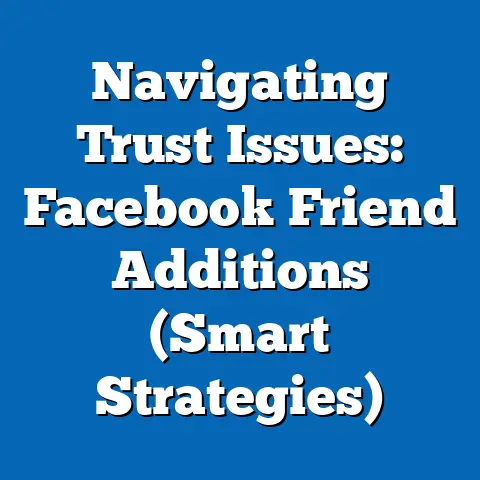Sell House Faster with Facebook Ads (Expert Strategies)
Sell House Faster with Facebook Ads (Expert Strategies): A Generational Perspective on Family Dynamics and Real Estate Marketing
Introduction: Bridging Family Dynamics and Real Estate Marketing
In the rapidly evolving landscape of real estate marketing, digital platforms like Facebook have emerged as powerful tools for connecting with potential home buyers and sellers. However, the effectiveness of these strategies often hinges on understanding the demographic and generational makeup of target audiences, particularly when it comes to family-oriented decisions like buying or selling a home. This article explores the intersection of family dynamics across generations and the application of expert strategies for selling houses faster using Facebook Ads, with a focus on how generational characteristics and historical contexts shape housing decisions.
Families, as the cornerstone of societal structure, play a pivotal role in real estate transactions, often influencing preferences for location, home size, and budget. By delving into the defining traits of key generations—Baby Boomers, Generation X, Millennials, and Generation Z—we can uncover how their unique experiences and values impact housing needs and marketing approaches. This analysis will provide a foundation for tailoring Facebook Ad campaigns to resonate with family-driven motivations, ultimately helping real estate professionals sell homes more efficiently.
Section 1: Understanding Family Through a Generational Lens
1.1 Defining Family in a Generational Context
The concept of family has evolved significantly over the past century, shaped by economic conditions, cultural norms, and technological advancements. While the traditional nuclear family—comprising two parents and their children—once dominated societal ideals, today’s families are increasingly diverse, including single-parent households, blended families, and multigenerational living arrangements. Generational differences further complicate these definitions, as each cohort approaches family life with distinct values and priorities influenced by the era in which they came of age.
Understanding these generational nuances is critical for real estate marketing, as family structures often dictate housing needs. For instance, younger generations may prioritize affordability and proximity to urban centers, while older generations may seek larger homes for multigenerational living or downsized properties for retirement. This section will explore the key characteristics of four major generations, focusing on how their views on family influence real estate decisions.
1.2 Baby Boomers (Born 1946–1964): The Post-War Family Ideal
Baby Boomers, born in the aftermath of World War II, grew up during a time of economic prosperity and social stability in many Western countries. This generation witnessed the rise of suburban living, with the “American Dream” often symbolized by owning a single-family home with a white picket fence. For Boomers, family was often synonymous with the nuclear model, and homeownership became a marker of success and stability.
Historically, Boomers experienced significant events like the Civil Rights Movement, the Vietnam War, and the advent of television, which shaped their values of hard work, loyalty, and traditionalism. As parents, many Boomers prioritized providing for their children, often investing in larger homes in suburban areas with good schools. Today, as they enter retirement, many are downsizing or relocating to warmer climates, yet they remain a significant force in the housing market, often helping their children or grandchildren with down payments.
Societally, Boomers’ influence on family structures has led to a lasting emphasis on homeownership as a family milestone. However, their aging population also raises questions about housing accessibility and multigenerational living, as many choose to “age in place” or move closer to family. For real estate marketers, understanding Boomers’ attachment to traditional family values and financial stability can inform ad messaging that emphasizes security and legacy.
1.3 Generation X (Born 1965–1980): The Latchkey Family
Generation X, often referred to as the “forgotten generation,” came of age during a period of economic uncertainty, marked by the oil crises of the 1970s, rising divorce rates, and the AIDS epidemic. As the first generation to experience widespread dual-income households, many Gen Xers grew up as “latchkey kids,” returning to empty homes after school while their parents worked. This fostered a sense of independence and skepticism toward institutions, including traditional family norms.
For Gen X, family structures began to diversify, with higher rates of single-parent households and blended families due to divorce and remarriage. Their approach to homeownership reflects pragmatism—many delayed buying homes due to economic challenges like the 1990s recession but eventually prioritized stability for their own children. Now in their 40s and 50s, Gen Xers often find themselves in the “sandwich generation,” balancing care for aging parents and growing children, which influences their housing needs for flexible, multigenerational spaces.
Societally, Gen X’s focus on work-life balance and adaptability has reshaped family expectations, emphasizing functionality over tradition in home choices. Real estate marketing to this group should highlight practical features like home offices or proximity to schools, as well as affordability, given their cautious financial outlook shaped by early career instability.
1.4 Millennials (Born 1981–1996): Redefining Family Amid Economic Challenges
Millennials, also known as Generation Y, grew up during the rise of the internet and came of age during the 2008 financial crisis, which profoundly impacted their views on family and homeownership. Unlike their parents, many Millennials delayed traditional milestones like marriage and parenthood due to student debt, stagnant wages, and housing unaffordability. As a result, their definition of family often includes chosen families—close friends or non-traditional partnerships—alongside delayed nuclear family formation.
Historically, Millennials have been shaped by events like 9/11, the Great Recession, and the digital revolution, fostering a generation that values experiences over material possessions and prioritizes flexibility. When it comes to housing, many Millennials rent longer than previous generations or opt for urban apartments over suburban homes, though a growing number are entering the market as they start families. Their preferences often lean toward sustainable, tech-friendly homes in walkable communities.
Societally, Millennials have driven trends like the gig economy and remote work, which influence their housing decisions by prioritizing location independence. For real estate marketers, appealing to Millennials requires a focus on affordability, community, and digital engagement, as this generation is highly active on social media platforms like Facebook.
1.5 Generation Z (Born 1997–2012): The Digital Family of the Future
Generation Z, the youngest cohort entering adulthood, is the first to grow up entirely in the digital age, with constant access to smartphones and social media. Shaped by events like the COVID-19 pandemic, climate change concerns, and ongoing economic uncertainty, Gen Z views family through a lens of diversity and inclusivity, often embracing non-traditional structures and multigenerational living due to financial necessity. Their early exposure to global issues has also made them socially conscious, valuing authenticity and sustainability.
While many Gen Zers are not yet in the housing market, their preferences are already emerging, with a focus on affordability, technology integration, and eco-friendly living. As digital natives, they are highly influenced by online content and peer recommendations, making platforms like Facebook critical for reaching them and their families. Their housing decisions are often collaborative, involving input from parents or older siblings, reflecting a reliance on family support in a challenging economic landscape.
Societally, Gen Z’s emphasis on diversity and digital connectivity is reshaping family dynamics, with implications for housing designs that accommodate shared living and remote work. Real estate marketers targeting Gen Z and their families should prioritize visual, engaging content on social platforms, emphasizing affordability and social impact.
1.6 Societal Implications of Generational Family Dynamics in Real Estate
The evolving definition of family across generations has significant implications for the housing market and society at large. Multigenerational living, driven by economic pressures and cultural shifts, is on the rise, with 20% of Americans living in multigenerational households as of 2021, according to Pew Research Center data. This trend necessitates homes with adaptable spaces, such as in-law suites or separate entrances, which marketers must highlight in their campaigns.
Additionally, the generational shift toward urban living among Millennials and Gen Z contrasts with Boomers’ suburban preferences, creating diverse demands in housing inventory. Economic disparities also play a role—while Boomers often have significant equity in their homes, younger generations struggle with affordability, leading to increased demand for rental properties and starter homes. Real estate marketing must address these disparities by offering tailored solutions that resonate with each generation’s family priorities.
Culturally, the diversification of family structures challenges traditional marketing narratives, requiring a more inclusive approach that reflects blended families, single-parent households, and non-traditional partnerships. By understanding these generational nuances, real estate professionals can craft Facebook Ad campaigns that speak directly to the unique needs and values of each cohort, ultimately driving faster home sales.
Section 2: Leveraging Facebook Ads to Sell Houses Faster
2.1 Why Facebook Ads? The Power of Social Media in Real Estate
Facebook remains one of the most effective platforms for real estate marketing, boasting over 2.9 billion monthly active users as of 2023, according to Statista. Its robust advertising tools, including detailed targeting options and visual formats like carousel ads and videos, make it ideal for showcasing properties to family-oriented buyers. Furthermore, Facebook’s user base spans all generations, allowing marketers to reach Boomers seeking retirement homes, Gen Xers looking for family-friendly properties, and Millennials entering the market.
2.2 Strategy 1: Segmenting Audiences by Generational Family Needs
Effective Facebook Ad campaigns begin with precise audience segmentation, ensuring that messaging aligns with the family dynamics and housing priorities of each generation. For Baby Boomers, ads should focus on retirement-friendly features like single-story layouts, low maintenance, and proximity to healthcare facilities, using language that emphasizes security and legacy. Visuals of peaceful, suburban settings can evoke nostalgia for their ideal family home.
For Generation X, campaigns should highlight practical benefits such as space for multigenerational living or home offices, addressing their “sandwich generation” challenges. Messaging that acknowledges their financial pragmatism—such as emphasizing value for money or investment potential—can be particularly effective. Including testimonials from similar-aged buyers can build trust with this skeptical cohort.
Millennials, as tech-savvy and socially conscious buyers, respond well to ads featuring sustainable home features, smart technology, and urban or community-focused locations. Dynamic video ads showcasing walkable neighborhoods or family-friendly amenities can capture their attention on Facebook. Additionally, offering resources like mortgage calculators or first-time buyer guides can address their affordability concerns.
Generation Z, though not yet a primary buying demographic, often influences family decisions through their digital presence. Ads targeting Gen Z-influenced families should prioritize visually striking content, such as 3D home tours or interactive posts, while emphasizing affordability and eco-friendliness. Engaging with their parents—often Gen X or older Millennials—through family-oriented messaging can also be effective.
2.3 Strategy 2: Crafting Compelling Visual and Emotional Content
Real estate is inherently visual, and Facebook’s ad formats—such as image carousels, videos, and 360-degree tours—offer unparalleled opportunities to showcase properties to family buyers. High-quality photos and videos that highlight family-friendly spaces, such as spacious kitchens, backyard play areas, or nearby schools, can create an emotional connection with potential buyers. For instance, a video tour showing a family enjoying a home’s amenities can resonate across generations by evoking shared aspirations.
Emotional storytelling is equally important, particularly when targeting family audiences. Ad copy should paint a picture of the lifestyle a home offers—whether it’s a Boomer envisioning grandkids visiting, a Gen Xer balancing work and family, or a Millennial starting anew. Phrases like “Create lifelong memories in this family haven” or “Your dream home awaits” can tap into universal family values while avoiding generational stereotypes.
Moreover, user-generated content, such as reviews or photos from past buyers, can build authenticity, especially for younger generations like Millennials and Gen Z who value peer recommendations. Hosting live virtual open houses on Facebook can also engage families directly, allowing them to ask questions and visualize themselves in the space.
2.4 Strategy 3: Utilizing Advanced Targeting and Retargeting Tools
Facebook’s advanced targeting capabilities allow real estate marketers to reach specific family demographics with precision. For example, targeting options like “parents with children under 18” or “recently engaged” can pinpoint Gen X and Millennial families in key life stages for home buying. Layering these with geographic targeting ensures ads reach families in desirable school districts or growing neighborhoods.
Interest-based targeting can also align with generational hobbies or concerns—targeting Boomers interested in retirement planning or Millennials following sustainable living pages can increase ad relevance. Behavioral targeting, such as reaching users who have visited real estate websites, further refines the audience to those actively in the market. Custom audiences, built from email lists or website visitors, can personalize ads for families who have already shown interest in a property.
Retargeting is a critical component of selling houses faster, as family buying decisions often involve multiple touchpoints. Retargeting ads can remind users of properties they’ve viewed, using dynamic ads that automatically update with relevant listings. Offering incentives like free home valuation tools or virtual consultations can re-engage hesitant families, nudging them toward a purchase.
2.5 Strategy 4: Optimizing for Mobile and Measuring Performance
Given that 98% of Facebook users access the platform via mobile devices (Statista, 2023), optimizing ads for smaller screens is non-negotiable, especially for younger generations like Millennials and Gen Z who are mobile-first. Ads should feature clear, concise text, bold visuals, and easy-to-tap call-to-action buttons like “Schedule a Tour” or “Learn More.” Vertical videos and stories ads, which occupy full-screen real estate on mobile, can be particularly effective for showcasing family homes.
Performance measurement is equally critical to refining campaigns for family audiences. Tracking metrics like click-through rates, engagement (comments and shares), and lead conversions can reveal which generational segments respond best to specific messaging. A/B testing different ad creatives—such as family-focused versus lifestyle-focused copy—can identify what resonates most with each cohort.
Facebook’s pixel and analytics tools also allow marketers to track offline conversions, such as home showings or sales, ensuring a clear return on investment. Adjusting budgets to prioritize high-performing ads and audiences—such as reallocating spend toward Millennials if they show higher engagement—can maximize efficiency in selling homes faster.
2.6 Strategy 5: Building Community and Trust Through Engagement
Families often seek homes in communities that align with their values, making engagement a powerful tool for real estate marketers on Facebook. Creating local community groups or pages where families can discuss neighborhood amenities, schools, or events can foster a sense of belonging, particularly for Gen X and Millennial buyers. Sharing content like local market updates or family-friendly activity guides positions agents as trusted resources.
Responding promptly to comments and messages on ads builds trust, especially for Boomers who value personal interaction, and Millennials who expect quick digital communication. Hosting Q&A sessions or webinars on topics like “Buying a Home for Your Growing Family” can address generational concerns directly, encouraging leads to move forward in the buying process.
Partnering with local family-oriented businesses or influencers—such as parenting bloggers for Millennials or retirement advisors for Boomers—can also amplify ad reach through authentic endorsements. Such collaborations resonate with families seeking a community connection, ultimately speeding up the decision-making process.
Section 3: Implications for Real Estate and Society
3.1 Transforming the Real Estate Industry with Generational Insights
The integration of generational family dynamics into real estate marketing via Facebook Ads has far-reaching implications for the industry. By tailoring campaigns to the unique needs of Boomers, Gen X, Millennials, and Gen Z, agents can reduce the time properties spend on the market, addressing the industry-wide challenge of stagnant listings. Personalized, data-driven ads also improve client satisfaction, fostering long-term relationships with families who feel understood and valued.
Moreover, the shift toward digital platforms like Facebook reflects a broader trend of technology reshaping real estate, from virtual tours to online transactions. This digital transformation benefits younger generations accustomed to online decision-making while requiring adaptation for older cohorts less familiar with tech. Real estate professionals must balance innovation with accessibility, ensuring all family demographics can engage with their marketing efforts.
3.2 Societal and Cultural Shifts in Family Housing Needs
The generational evolution of family structures influences societal norms around housing, pushing for more inclusive urban planning and home designs. Multigenerational living, driven by economic necessity across Gen X, Millennials, and Gen Z, necessitates zoning changes and architectural innovations to accommodate diverse family units. Real estate marketing must advocate for these shifts by showcasing properties that meet emerging needs, reinforcing their role in shaping community development.
Culturally, the diversification of family definitions challenges traditional real estate narratives, requiring marketers to adopt inclusive language and imagery in Facebook Ads. Highlighting stories of non-traditional families or emphasizing community over ownership can resonate with younger generations, fostering a more equitable housing market. This cultural sensitivity not only drives sales but also contributes to a broader societal acceptance of varied family models.
3.3 Workplace and Economic Impacts
For real estate professionals, adopting generational-targeted Facebook Ad strategies impacts workplace dynamics by necessitating digital upskilling and cross-generational collaboration. Agents must stay abreast of social media trends to connect with younger families while maintaining traditional outreach for older clients, creating a hybrid skill set. Economically, faster home sales driven by effective ads can stimulate local markets, benefiting related industries like construction and home services.
However, economic disparities between generations—such as Boomers’ wealth accumulation versus Millennials’ debt burden—pose challenges for equitable marketing. Real estate campaigns must offer solutions like financing options or affordable listings to bridge these gaps, ensuring families across cohorts can access homeownership. This balance is critical for sustaining market growth while addressing systemic inequalities.
Conclusion: Forward-Looking Insights for Real Estate Marketing
Selling houses faster with Facebook Ads requires a deep understanding of generational family dynamics, blending demographic insights with cutting-edge digital strategies. By recognizing the historical contexts and societal shifts that shape Baby Boomers, Generation X, Millennials, and Generation Z, real estate professionals can craft targeted campaigns that resonate emotionally and practically with diverse family needs. From segmenting audiences and creating compelling content to leveraging advanced targeting tools, these expert strategies offer a roadmap for accelerating sales in a competitive market.
Looking ahead, the intersection of family and real estate marketing will continue to evolve with technological advancements and societal changes. Emerging trends like augmented reality home tours or AI-driven ad personalization may further refine how families engage with properties online, while ongoing economic and cultural shifts will redefine housing priorities. However, uncertainties remain—such as the long-term impact of remote work on family location preferences or the housing affordability crisis for younger generations.
Real estate marketers must remain agile, continuously adapting to generational nuances and platform innovations to stay ahead. By prioritizing authenticity, inclusivity, and data-driven decision-making, they can not only sell houses faster but also contribute to a housing market that reflects the diverse, evolving nature of family in the 21st century. As the digital and demographic landscapes shift, the ability to connect with families on a personal level will remain the cornerstone of successful real estate marketing.






